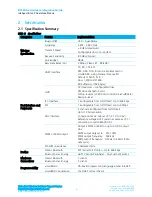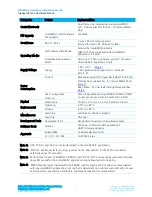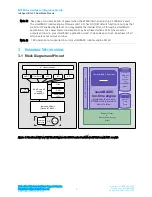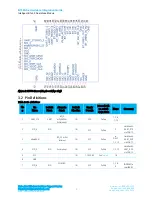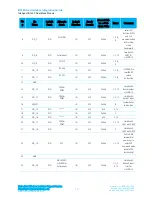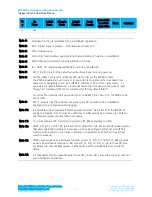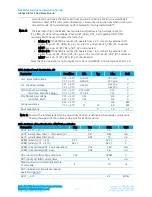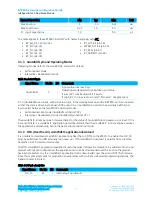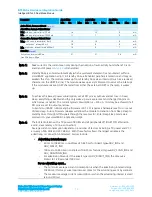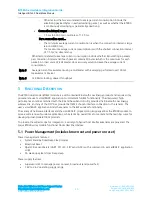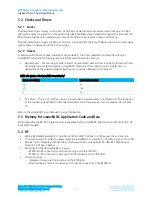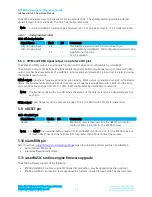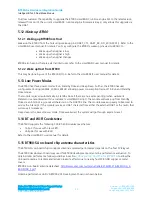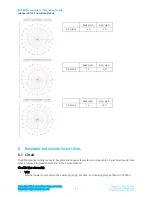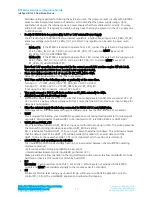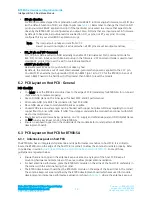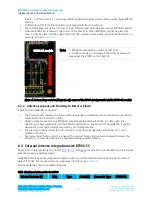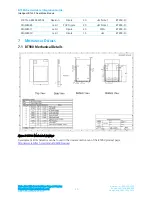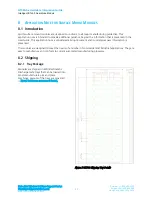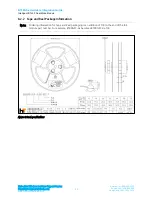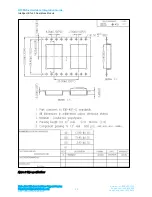
BT900-Sx Hardware Integration Guide
Intelligent BTv4.0 Dual Mode Module
Embedded Wireless Solutions Support Center:
http://ews-support.lairdtech.com
www.lairdtech.com/bluetooth
19
Americas: +1-800-492-2320
Europe: +44-1628-858-940
Hong Kong: +852 2923 0610
Parameter
At 40 MHz
At 20 MHz
At 4 MHz
Min
Typ
Max
Min
Typ
Max
Min
Typ
Max
Unit
Active Mode Average Current (
Advertising Average Current Draw
Max with adv. interval (min) 20 mS
16
12
9
mA
Min with adv. interval (max) 10240 mS
11
7
5
mA
Connection Average Current Draw
Max, with conn. interval (min) 8 mS
19
10
8
mA
with conn. interval 68 mS
19
9
8
mA
Min, with conn. interval (max) 4000 mS
19
9
7
mA
Scanning (
Active Scan Interval = 80ms,
Scan Window = 40ms
31
31
26
mA
Note 1:
Peak current is the current seen only during the duration of radio activity burst where TX is on
and transmit power in
Note 2:
Standby Doze is entered automatically (when a
waitevent
statement is encountered within a
smart
BASIC application script). In Standby Doze, all enabled peripherals remain on and may re-
awaken the chip. The module wakes up from Standby Doze via an interrupt (such as a received
character on the UART Rx line). The module wakes up every millisecond to service the interrupt.
If the module receives a UART character from either the external UART or the radio, it wakes
up.
Note 3:
To achieve the lowest power consumption, set all SIO pins as outputs and set low. In Deep
Sleep, everything is disabled and the only wake-up sources are reset and changed on pins on
which sense is enabled. The current typical consumption is ~233 uA. 7uA may be achieved if all
SIO pins are set to outputs and low.
Current
smart
BASIC runtime engine firmware (v9.1.2.0) requires a hardware reset to come out
of deep sleep. Future firmware releases will allow the module to transition from Deep Sleep to
Standby Doze through GPIO signals through the reset vector. Enter Deep Sleep mode via a
command in your
smart
BASIC application script.
Note 4:
The BLE radio taken with a TX power of 8 dBm and all peripherals off (UART OFF after radio
event), slave latency of 0 (in a connection).
Average current consumption depends on a number of factors including a TX power and VCC
accuracy of 26 MHz and 32.768 kHz. With these factors fixed, the largest variable is the
advertising or connection interval set. Factors include:
Advertising Interval range:
-
20 ms to 10240 ms in multiples of 0.625 ms for Advert type=ADV_IND and
ADV_DIRECT_IND
-
100 ms to 10240 ms in multiples of 0.625 ms for Advert type=ADV_SCAN_IND and
ADV_NONCONN_IND
-
For advertising timeout, if the advert type is ADV_DIRECT_IND, the timeout is
limited to 1.28 seconds (1280 ms).
For an advertising event…
-
The minimum average current consumption is when the advertising interval is large
10240 mS (this may cause long discover times for the advertising event by scanners.
-
The maximum average current consumption is when the advertising interval is small
(around 20 ms).


